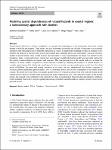Item Infomation
Full metadata record
| DC Field | Value | Language |
|---|---|---|
| dc.contributor.author | Chaudhuri, Somnath | - |
| dc.contributor.author | Juan, Pablo | - |
| dc.contributor.author | Saurina, Laura Serra | - |
| dc.date.accessioned | 2023-08-07T07:12:43Z | - |
| dc.date.available | 2023-08-07T07:12:43Z | - |
| dc.date.issued | 2023 | - |
| dc.identifier.uri | https://link.springer.com/article/10.1007/s00477-023-02519-9 | - |
| dc.identifier.uri | https://dlib.phenikaa-uni.edu.vn/handle/PNK/8722 | - |
| dc.description | CC-BY | vi |
| dc.description.abstract | Natural hazards like floods, cyclones, earthquakes, or, tsunamis have deep impacts on the environment and society causing damage to both life and property. These events can cause widespread destruction and can lead to long-term socio-economic disruption often affecting the most vulnerable populations in society. Computational modeling provides an essential tool to estimate the damage by incorporating spatial uncertainties and examining global risk assessments. Classical stationary models in spatial statistics often assume isotropy and stationarity. It causes inappropriate smoothing over features having boundaries, holes, or physical barriers. Despite this, nonstationary models like barrier model have been little explored in the context of natural disasters in complex land structures. | vi |
| dc.language.iso | en | vi |
| dc.publisher | Springer | vi |
| dc.subject | coastal regions | vi |
| dc.subject | nonstationary | vi |
| dc.title | Modeling spatial dependencies of natural hazards in coastal regions: a nonstationary approach with barriers | vi |
| dc.type | Book | vi |
| Appears in Collections | ||
| OER - Khoa học môi trường | ||
Files in This Item:

